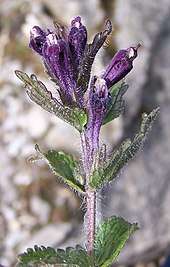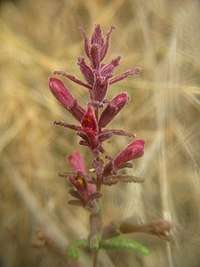Bartsia
Bartsia is a genus of flowering plants in the family Orobanchaceae.
| Bartsia | |
|---|---|
 | |
| Bartsia alpina | |
| Scientific classification | |
| Kingdom: | Plantae |
| Clade: | Tracheophytes |
| Clade: | Angiosperms |
| Clade: | Eudicots |
| Clade: | Asterids |
| Order: | Lamiales |
| Family: | Orobanchaceae |
| Tribe: | Rhinantheae |
| Genus: | Bartsia L. |


Bartsia grows in damp places, such as marshes and wet meadows, in several parts of the west of England and Wales and in southwest Scotland.[1]
Etymology
Bartsia was named after Johann Bartsch (Latinized as Johannes Bartsius, 1709-1738), a botanist of Königsberg. The plant was named for him by his associate Carl Linnaeus, and the genus has been sometimes spelt as Bartschia.[2]
Starbia, an anagram of Bartsia, is another genus of Orobanchaceae, synonym of Alectra.[3]
Phylogeny
The phylogeny of the genera of Rhinantheae has been explored using molecular characters.[4][5] Bartsia belongs to the core Rhinantheae. Bartsia sensu stricto (e.g. B. alpina) is the sister genus to Odontites, Bellardia, Tozzia, Hedbergia, and Euphrasia.
| Genus-level cladogram of tribe Rhinantheae. | |||||||||||||||||||||||||||||||||||||||||||||||||||||||||||||||
| |||||||||||||||||||||||||||||||||||||||||||||||||||||||||||||||
| The cladogram has been reconstructed from nuclear and plastid DNA molecular characters (ITS, rps16 intron and trnK region).[4][5] |
Classification
In 1990, the genus was revised to contain 49 species; 45 of them are endemic to the Andes.[6] The most familiar species might be the well-studied Bartsia alpina, which has a circumboreal distribution, occurring throughout northern regions of the Northern Hemisphere.[7] There are also two afromontane species, restricted to the mountains of northeastern Africa: Bartsia decurva and Bartsia longiflora. These two plants, B. alpina, and the many Andean species are three distinct lineages, making the genus polyphyletic.[8][5][9]
As a solution to the problem of Bartsia polyphyly, two taxonomic adjustments have been proposed.
- All South American species are reclassified into the new genus Neobartsia.[9] This new name keeps traceability with Bartsia while incorporating information about its New World distribution (in ancient Greek, νέος, i.e. néos, means 'new').
- The two African species Bartsia decurva and Bartsia longiflora are reclassified into the existing genus Hedbergia.[5]
Accepted species names include the following taxa classified according to geographic distribution groups.[10][9]
Europe
- Bartsia alpina L. – velvetbells
Mediterranean Basin
- Bartsia trixago L.
Northeastern Africa
- Hedbergia decurva, synonym of Bartsia decurva Hochst. ex Benth.
- Hedbergia longiflora, synonym of Bartsia longiflora Hochst. ex Benth.
Andean South America
- Bartsia acuminata Pursh
- Bartsia altissima Rusby
- Bartsia anomala Edwin
- Bartsia asperrima (Link) Samp.
- Bartsia aurea Edwin
- Neobartsia adenophylla (Molau) Uribe-Convers & Tank, comb. nov.
- Neobartsia alba (Molau) Uribe-Convers & Tank, comb. nov.
- Neobartsia aprica (Diels) Uribe-Convers & Tank, comb. nov.
- Neobartsia australis (Molau) Uribe-Convers & Tank, comb. nov.
- Neobartsia bartsioides (Hook.) Uribe-Convers & Tank, comb. nov.
- Neobartsia camporum (Diels) Uribe-Convers & Tank, comb. nov.
- Neobartsia canescens (Wedd.) Uribe-Convers & Tank, comb. nov.
- Neobartsia chilensis (Benth.) Uribe-Convers & Tank, comb. nov.
- Neobartsia crenata (Molau) Uribe-Convers & Tank, comb. nov.
- Neobartsia crenoloba (Wedd.) Uribe-Convers & Tank, comb. nov.
- Neobartsia crisafullii (N.H.Holmgren) Uribe-Convers & Tank, comb. nov.
- Neobartsia diffusa (Benth.) Uribe-Convers & Tank, comb. nov.
- Neobartsia elachophylla (Diels) Uribe-Convers & Tank, comb. nov.
- Neobartsia elongata (Wedd.) Uribe-Convers & Tank, comb. nov.
- Neobartsia fiebrigii (Diels) Uribe-Convers & Tank, comb. nov.
- Neobartsia filiformis (Wedd.) Uribe-Convers & Tank, comb. nov.
- Neobartsia flava (Molau) Uribe-Convers & Tank, comb. nov.
- Neobartsia glandulifera (Molau) Uribe-Convers & Tank, comb. nov.
- Neobartsia inaequalis (Benth.) Uribe-Convers & Tank, comb. nov.
- Neobartsia integrifolia (Wedd.) Uribe-Convers & Tank, comb. nov.
- Neobartsia jujuyensis (Cabrera & Botta) Uribe-Convers & Tank, comb. nov.
- Neobartsia laniflora (Benth.) Uribe-Convers & Tank, comb. nov.
- Neobartsia laticrenata (Benth.) Uribe-Convers & Tank, comb. nov.
- Neobartsia lydiae (Sylvester) Uribe-Convers & Tank, comb. nov.
- Neobartsia melampyroides (Kunth) Uribe-Convers & Tank, comb. nov.
- Neobartsia mutica (Kunth) Uribe-Convers & Tank, comb. nov.
- Neobartsia orthocarpiflora (Benth.) Uribe-Convers & Tank, comb. nov.
- Neobartsia patens (Benth.) Uribe-Convers & Tank, comb. nov.
- Neobartsia pauciflora (Molau) Uribe-Convers & Tank, comb. nov.
- Neobartsia pedicularoides (Benth.) Uribe-Convers & Tank, comb. nov.
- Neobartsia peruviana (Walp.) Uribe-Convers & Tank, comb. nov.
- Neobartsia pumila (Benth.) Uribe-Convers & Tank, comb. nov.
- Neobartsia pyricarpa (Molau) Uribe-Convers & Tank, comb. nov.
- Neobartsia ramosa (Molau) Uribe-Convers & Tank, comb. nov.
- Neobartsia remota (Molau) Uribe-Convers & Tank, comb. nov.
- Neobartsia rigida (Molau) Uribe-Convers & Tank, comb. nov.
- Neobartsia santolinifolia (Kunth) Uribe-Convers & Tank, comb. nov.
- Neobartsia sericea (Molau) Uribe-Convers & Tank, comb. nov.
- Neobartsia serrata (Molau) Uribe-Convers & Tank, comb. nov.
- Neobartsia stricta (Kunth) Uribe-Convers & Tank, comb. nov.
- Neobartsia strigosa (Molau) Uribe-Convers & Tank, comb. nov.
- Neobartsia tenuis (Molau) Uribe-Convers & Tank, comb. nov.
- Neobartsia thiantha (Diels) Uribe-Convers & Tank, comb. nov.
- Neobartsia tomentosa (Molau) Uribe-Convers & Tank, comb. nov.
- Neobartsia trichophylla (Wedd.) Uribe-Convers & Tank, comb. nov.
- Neobartsia tricolor (Molau) Uribe-Convers & Tank, comb. nov.
- Neobartsia weberbaueri (Diels) Uribe-Convers & Tank, comb. nov.
References
- Pratt, Anne (1899). The Flowering Plants, Grasses, Sedges,& Ferns of Great Britain and Their Allies, the Club Mosses, Horsetails, Etc. London: F. Warne. p. 26.
- Gentil, Ambroise (1923). Dictionnaire étymologique de la flore française (PDF). Paris: Paul Lechevalier. p. 31.
- Burkhardt, Lotte (2018-06-06). Verzeichnis eponymischer Pflanzennamen - Erweiterte Edition. Index of Eponymic Plant Names - Extended Edition. Index de Noms éponymiques des Plantes - Édition augmentée (in German). Botanic Garden and Botanical Museum Berlin, Freie Universität Berlin. p. B21. doi:10.3372/epolist2018. ISBN 978-3-946292-26-5.
- Těšitel, Jakub; Říha, Pavel; Svobodová, Šárka; Malinová, Tamara; Štech, Milan (2010-10-28). "Phylogeny, Life History Evolution and Biogeography of the Rhinanthoid Orobanchaceae". Folia Geobotanica. 45 (4): 347–367. doi:10.1007/s12224-010-9089-y. ISSN 1211-9520.
- Scheunert, Agnes; Fleischmann, Andreas; Olano-Marín, Catalina; Bräuchler, Christian; Heubl, Günther (2012-12-14). "Phylogeny of tribe Rhinantheae (Orobanchaceae) with a focus on biogeography, cytology and re-examination of generic concepts". Taxon. 61 (6): 1269–1285. doi:10.1002/tax.616008.
- Molau, Ulf (1990). "The genus Bartsia (Scrophulariaceae-Rhinanthoideae)". Opera Botanica. 102: 5–99.
- Taylor, K. and F. J. Rumsey. (2003). Bartsia alpina L. Journal of Ecology 91(5), 908-21.
- Uribe-Convers, S. and D. Tank. Phylogenetic analysis of the genus Bartsia L. (Orobanchaceae): a mostly South American genus wrapped in a European Clade. Presentation abstract. Botany 2010. Providence, Rhode Island. August 4, 2010.
- Uribe-Convers, Simon; Tank, David C. (2016-09-01). "Phylogenetic Revision of the Genus Bartsia (Orobanchaceae): Disjunct Distributions Correlate to Independent Lineages". Systematic Botany. 41 (3): 672–684. doi:10.1600/036364416X692299.
- Bartsia. The Plant List.
| Wikimedia Commons has media related to Bartsia. |